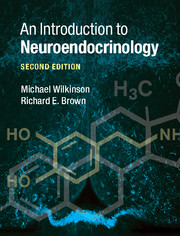Book contents
- Frontmatter
- Dedication
- Contents
- Preface to the second edition
- Acknowledgements
- List of abbreviations
- 1 Classification of chemical messengers
- 2 The endocrine glands and their hormones
- 3 The pituitary gland and its hormones
- 4 The hypothalamic hormones
- 5 Neurotransmitters
- 6 Neurotransmitter and neuropeptide control of hypothalamic, pituitary and other hormones
- 7 Regulation of hormone synthesis, storage, release, transport and deactivation
- 8 Regulation of hormone levels in the bloodstream
- 9 Steroid and thyroid hormone receptors
- 10 Receptors for peptide hormones, neuropeptides and neurotransmitters
- 11 Neuropeptides I: classification, synthesis and co-localization with classical neurotransmitters
- 12 Neuropeptides II: function
- 13 Cytokines and the interaction between the neuroendocrine and immune systems
- 14 Methods for the study of behavioral neuroendocrinology
- 15 An overview of behavioral neuroendocrinology: present, past and future
- Index
- References
2 - The endocrine glands and their hormones
Published online by Cambridge University Press: 05 June 2015
- Frontmatter
- Dedication
- Contents
- Preface to the second edition
- Acknowledgements
- List of abbreviations
- 1 Classification of chemical messengers
- 2 The endocrine glands and their hormones
- 3 The pituitary gland and its hormones
- 4 The hypothalamic hormones
- 5 Neurotransmitters
- 6 Neurotransmitter and neuropeptide control of hypothalamic, pituitary and other hormones
- 7 Regulation of hormone synthesis, storage, release, transport and deactivation
- 8 Regulation of hormone levels in the bloodstream
- 9 Steroid and thyroid hormone receptors
- 10 Receptors for peptide hormones, neuropeptides and neurotransmitters
- 11 Neuropeptides I: classification, synthesis and co-localization with classical neurotransmitters
- 12 Neuropeptides II: function
- 13 Cytokines and the interaction between the neuroendocrine and immune systems
- 14 Methods for the study of behavioral neuroendocrinology
- 15 An overview of behavioral neuroendocrinology: present, past and future
- Index
- References
Summary
The endocrine glands
The location of the human endocrine glands is shown in Figure 2.1. The pineal gland is a small gland lying deep between the cerebral cortex and the cerebellum at the posterior end of the third ventricle in the middle of the brain. The hypothalamus exerts some degree of control over most of the endocrine glands through the release of neurohormones, neuropeptides and neurotransmitters. The pituitary gland hangs from the bottom of the hypothalamus at the base of the brain and sits in a small cavity of bone above the roof of the mouth.
The thyroid gland is located in the neck and the small parathyroid glands are embedded in the surface of the thyroid. In the chest is the thymus gland, which is very important for the production of T lymphocytes that play a critical role in the immune response. The heart and lungs also act as endocrine glands that secrete hormones. The gastrointestinal (GI) tract, consisting of the stomach and intestines, is also an important source of hormones. The liver secretes several hormones such as somatomedin (also called IGF-1), important for growth. The adrenal glands are complex endocrine glands situated on top of the kidneys. The pancreas secretes hormones involved in regulating blood sugar levels and the kidney also produces hormone-like chemicals. The testes and ovaries produce gonadal hormones, or sex hormones, which, in addition to the maintenance of fertility and sex characteristics, have important effects on behavior. During pregnancy, the placenta acts as an endocrine gland. The endocrine glands occur in similar locations in all vertebrates. A large endocrine gland is fat (adipose tissue) which can be found beneath the skin (subcutaneous), in the abdominal cavity surrounding the heart and GI tract (see Figure 2.1), and within tissues such as liver and muscle. Fat secretes a variety of hormones called adipokines. Finally, two of the largest tissues in the body – skeletal muscle and bone – secrete factors that act in an endocrine fashion.
- Type
- Chapter
- Information
- An Introduction to Neuroendocrinology , pp. 19 - 44Publisher: Cambridge University PressPrint publication year: 2015



